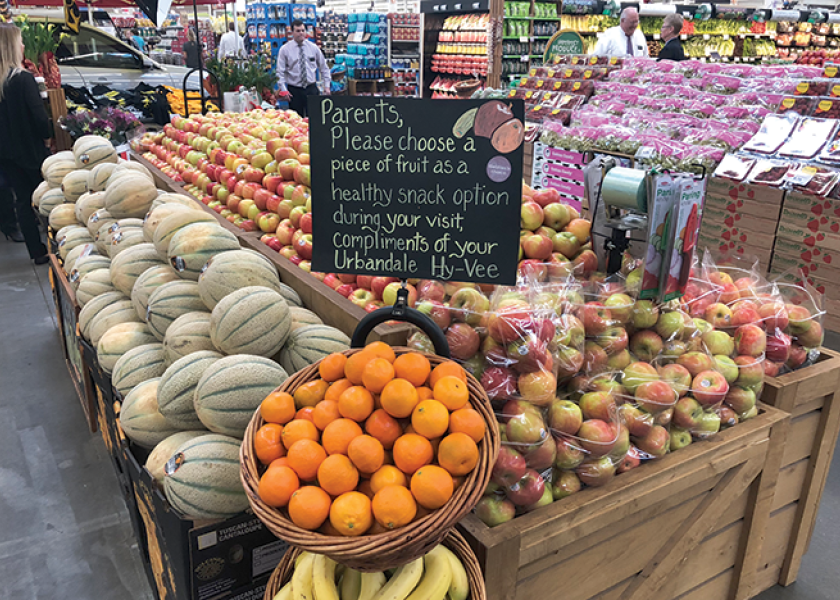Walmart, Hy-Vee battle for Midwest

Walmart, Hy-Vee and Associated Wholesale Grocers are three of the heavyweights in the Midwest markets, industry sources and Shelby Market data show.
In the Kansas-Missouri market (including Kansas City; Topeka, Kan.; Wichita, Kan.; and Columbia, Mo.) Shelby reports that Walmart commands a 31.6% market share, compared with 26.9% for Associated Wholesale Grocers, 15.6% for Dillons (Kroger), 9.6% for HyVee, 8.5% for Costco and 6.5% for SuperTarget and 2.8% for Aldi.
For the market defined as Nebraska/Colorado/Iowa/Kansas/South Dakota (Omaha, Lincoln and Sioux Falls), Shelby report Walmart’s share was 32%, followed by Hy-Vee with a 20.6% share, and Associated Wholesale Grocers with a 16.5% share.
Other leading stores include Dillons (Kroger) with a 13.9% share and SuperTarget with a 10.6% share.
In the Iowa/Illinois/Montana/Minnesota market (Des Moines, Sioux City, Cedar Rapids), Hy-Vee holds a market share of 37.8%, followed by a 28.6% share for Walmart.
Economy and outlook
Although finding labor and retaining talent remains a challenge for produce distributors, some belt-tightening in the rural economy may be coming because of poor grain prices.
“The overall economy in the Midwest seems to be slowing,” said Brendan Comito, chief operations officer for Norwalk, Iowa-based Capital City Fruit.
“Ag commodity prices are depressed and the tariffs are certainly not helping.”
While some observers say organic growth has been muted compared with some years, locally grown produce has performed well.
Coming off of the summer, Midwest retailers are continuing to make strides in featuring locally grown produce, said Anthony Totta, founder of FreshXperts. Retailers are establishing a locally grown presence and improving their merchandising strategies, segregating local produce and promoting it when available.
Local push
Steve May, director of retail business development for C&C Produce, Kansas City, Mo., said the three strongest areas of growth for the company are fresh-cut, organic and local produce.
With Chris Shea, director of local grown sales, C&C has a person dedicated to help identify and work with local growers in a multi-state region, May said, including produce from Arkansas, Kansas, Missouri, Nebraska, Oklahoma, Illinois and Michigan.
“Chris is so patient and he doesn’t mind the hard work of getting in his car and driving several hundred miles to go check out growers,” said Nick Conforti, co-owner of C&C Produce.
“We have to take food safety just as serious with the local grower as we do shippers in California — they are all GAP-certified.”
For produce operators in some parts of the Midwest, Mother Nature has made life difficult at times in 2019. Besides an extremely cold and record snowy winter in Iowa that dimmed some foodservice opportunities, the start of the growing season was less than ideal as well.
Comito said the local deal got off to a slow start due to more rain than usual in the spring, and several areas in the Midwest also dealt with severe floods.
“The good news is that the late start and the mild fall temps have extended the season beyond normal.”
Comito said local produce hits the sweet spot for consumers.
“It seems like here in the Midwest, locally grown carries more weight than organic does,” he said.
“People go crazy for the local stuff, whether it’s conventional or organic.”
Another positive development is the trend toward vegetarian diets, Comito said.
“That’s a slow trend, but I think you’re going to see more and more of it,” he said. “We are starting to see it in some of the menus that restaurants are carrying; you are seeing a lot of more alternative dishes to meat.”
In terms of produce promotions in general, Totta said some retailers would benefit by breaking out of old habits and get closer to listening to what consumers want.
“Variety and novelty and experiential is where it is what with these next generations coming up,” Totta said.
That means giving consumers time and opportunity to discover new varieties. Pricing multiple apple varieties on a single average cost basis, for example, could reveal the appeal of newer varieties.
Related content:
Liberty Fruit tournament raises $152,000 for hospital
C&C Produce awarded defense contract
AWG enlists ProfitTrax to help retailers reduce shrink







